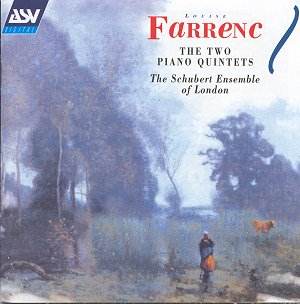Perhaps the time is ripe for a reappraisal of the talents
of French composer Louise Farrenc. In addition to the present disc,
Pierre Verany has issued this composer's three Symphonies on a two-disc
set (PV700030, with the Orchestre de Bretagne under Stefan Sanderling)
and, if the Schubert Ensemble of London’s fresh accounts of these two
Piano Quintets convince you of this composer’s worth, that is the logical
next step. The Symphonies are similarly imbued with a freshness of invention
that is guaranteed to delight.
Farrenc was a pupil of Antonin Reicha (1770-1836),
but studied also with Hummel and Moscheles. She was a Professor of Piano
at the Paris Conservatoire, beginning in 1842 and holding the post for
over thirty years. Both Schumann and Berlioz had good words to say about
her. The good news is that there is a large output of solo piano music,
four piano trios and more chamber music to discover. If these pieces
continue in this vein, this is indeed a rich avenue to explore.
The Piano Quintets on this disc are beautiful, enchanting
music. Those lucky enough to attend concerts given by the Schubert Ensemble
of London will know of their superb rapport, possibly kept fresh by
their insatiable musical curiosity in combination with their laudable
championship of the music of our time. Here they successfully convey
the sense of freshness of discovery, whether in the virtuoso Scherzo
of No. 1 (the Trio has a real spring in its step) or in the singing,
expressive Adagio non troppo of the same quintet. In this latter movement,
set off by Jane Salmon’s movingly expressive cello playing, Farrenc’s
imagination is at its highest as she makes full use of the available
sonorities.
The First Quintet dates from 1829. The Second, from
the next year, the invention continues unabated. The first movement
includes a slow introduction (Andante sostenuto), but these are hardly
storm clouds on the horizon, and the Allegro grazioso arrives like a
breath of fresh air. The delicacy of the Grave second movement is particularly
affecting; once more, the last movement is positively bursting with
joyous energy.
The recording is excellent, with little of the dryness
which can mark discs from this company. Very much recommended.
Colin Clarke


